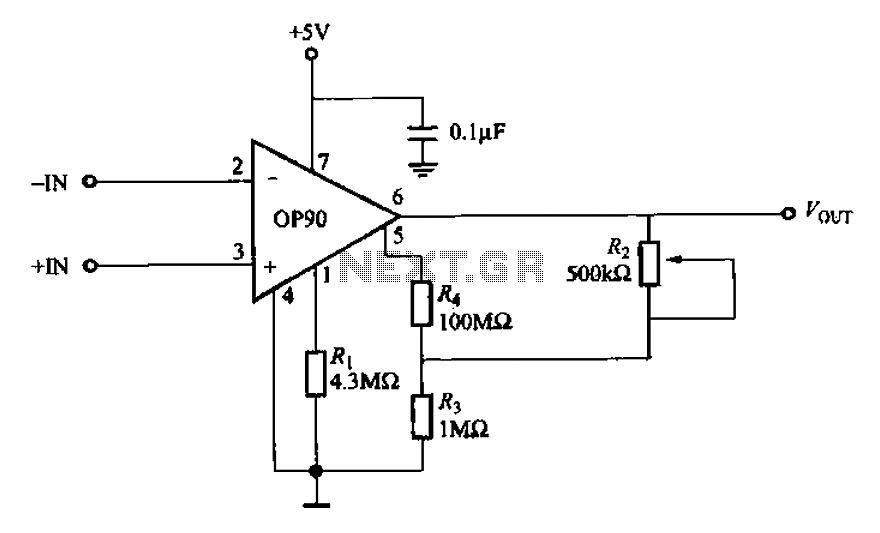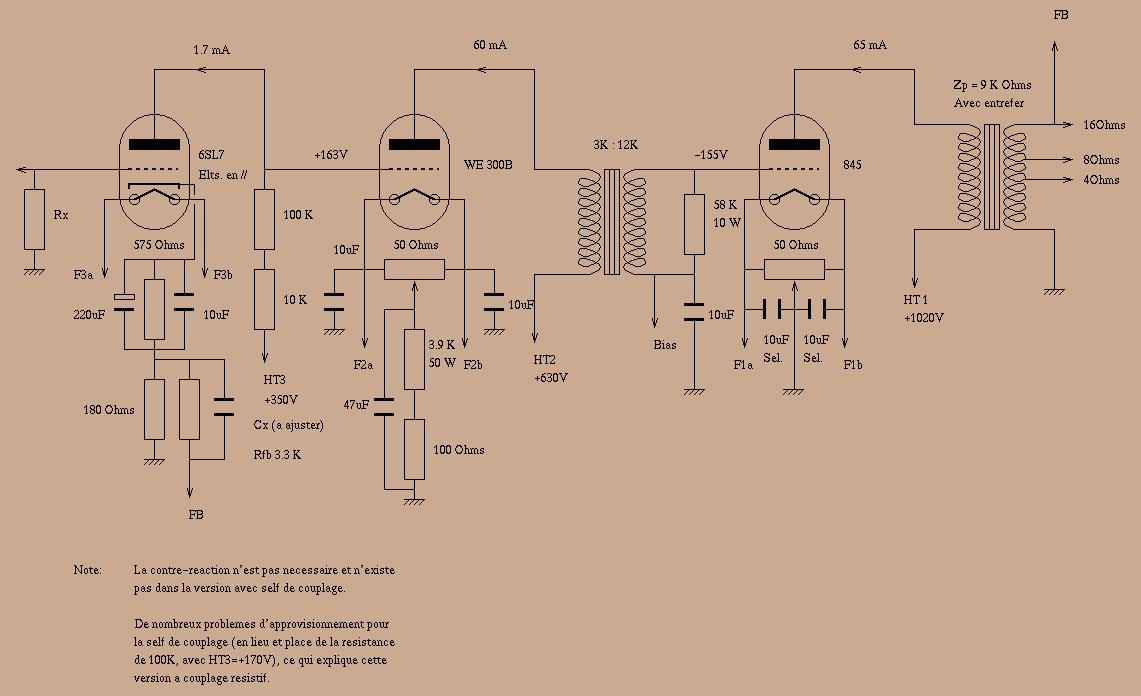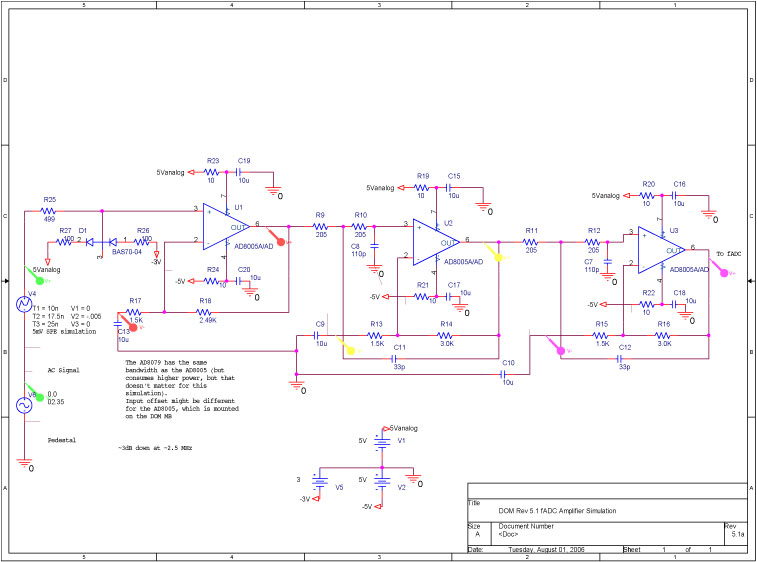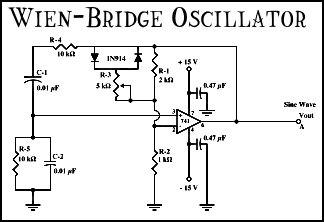
RF amplifier and filter for 2.5MHz
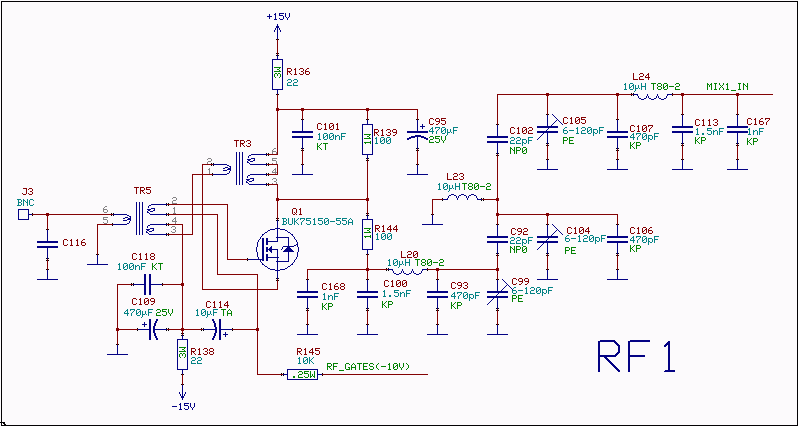
By using transformers, both voltage feedback and current feedback can be applied. An article by DJ2LR Ulrich Rohde in Ham Radio, November 1979, provides details about this circuit. For the 2.5 MHz to audio converter, the transformation ratio from drain to source is 2:1. The output transformer, TR3 in Figure 1, consists of 9 turns trifilar wound on a 16 mm toroid. Two of the windings are connected in series on the drain side. The drain is loaded with one 100-ohm resistor to ground and another 100-ohm resistor to the bandpass filter. The input impedance of the filter is approximately 100 ohms within the passband, although it varies slightly. Outside the passband, the input impedance of the filter is lower. The impedance at the drain of the transistor is very low due to feedback, ensuring that the impedance feeding the filter remains at 100 ohms regardless of the impedance connected to the amplifier's input. The third-order input intercept point (IP3) of the amplifier is about 40 dBm, while the 1 dB compression point occurs at +15 dBm, indicating clipping at the drain. At this point, the RF voltage at the drain reaches 20V, resulting in 0.4W of power absorbed in the 100-ohm resistor. When two input signals of +8 dBm are applied, the third-order intermodulation (IM) is at -55 dBc, while two signals at 0 dBm yield IM3 at -81 dBc. The input transformer, TR5 in Figure 1, steps up the voltage by a factor of 2.5 from the antenna input to the gate. The source current is routed through a small winding to create a load on the transformer that results in a 50-ohm input impedance. The input transformer is loaded by the input capacitance of the transistor, and the inductance of the transformer balances for a low Q resonance at 2.5 MHz. By reducing the number of turns on the transformer and adding a capacitor at the input (C116 in Figure 1), it would be possible to increase the Q of the input resonance, effectively attenuating signals well away from 2.5 MHz. However, the final design does not utilize any capacitor at C116, as 2.5 MHz is an IF frequency, and the preceding stages cannot emit signals significantly away from 2.5 MHz at levels that would impact the 2.5 MHz amplifier. Therefore, a high Q in the input transformer is not necessary. The input transformer, TR5, is wound on a Ferroxcube ferrite toroid core (Material 4C65, type TN 14/9/5). The gate winding consists of 31 turns, the source winding has 3 turns, and the input winding comprises 12 turns. The wire dimensions are not critical. These inductors are essential; for instance, using a single toroid Amidon T80-2 with about 40 turns for these inductors results in a 10 dB degradation of IP3 within the passband. Air core coils, while larger for a similar Q, can achieve a higher IP3. Therefore, the use of Amidon cores is advisable. Outside the passband, a significantly smaller voltage is present across the inductors, causing IP3 to gradually transition from 30 dBm within the passband to 40 dBm for signals well outside it. Within the passband, the dynamic range is limited by the Delta44 saturation at -16 dBm, making an IP3 of 30 dBm correspond to third-order intermodulation at -90 dBc with near-saturating signals. When one near-saturating signal is introduced into one channel of the 2.5 MHz to audio converter, the spectrum appears as shown in Figures 4 and 5. The prototype includes only one channel, displaying both upper and lower sidebands resulting from mixing with 2.5 MHz. When two channels of this type are combined as I and Q, the noise floor decreases by 3 dB. In practice, the noise floor increases by 3 dB, while signals increase by 6 dB, a compensation handled by Linrad. When both signals are applied simultaneously, the amplitude must be reduced by 6 dB to maintain the same peak value as depicted in Figures 4 and 5. An intermodulation test illustrating this is presented in Figure 6, which shows two signals with equal amplitudes, 2.409 MHz and 2.509 MHz. Each signal is attenuated by 6 dB compared to Figures 4 and 5, respectively, but their combined amplitude is...
The circuit described employs transformers to facilitate feedback mechanisms and impedance matching, which are critical for the performance of RF amplifiers. The use of a trifilar wound output transformer allows for efficient energy transfer from the transistor's drain to the load, while maintaining the desired impedance levels. The careful selection of resistor values and transformer turns is essential for ensuring optimal performance across the frequency range of interest.
The design also highlights the importance of maintaining a low Q factor at the input transformer to avoid unwanted resonance effects that could interfere with signal integrity. The choice of ferrite core materials, such as those from Ferroxcube, is significant in achieving the desired inductance without compromising the amplifier's linearity.
Furthermore, the third-order intermodulation performance is a key indicator of the amplifier's ability to handle multiple signals without distortion. The relationship between the input signal levels and the resulting intermodulation products illustrates the need for careful signal management in applications such as communications and broadcasting.
Overall, the circuit exemplifies the interplay between various components and their configurations to achieve high performance in RF amplification, making it suitable for applications that require precise signal processing and fidelity.By use of transformers one can apply both voltage feedback and current feedback. There was an article in Ham Radio november 1979 by DJ2LR Ulrich Rohde giving details about this circuit. For the 2. 5MHz to audio converter the transformation ratio from drain to source is 2:1. The output transformer, TR3 in fig. 1, is 9 turns trifilar wound on a 16 mm toroid. Two of the windings are connected in series at the drain side. The drain is loaded by one 100 ohm resistor to ground and one 100 ohm resistor to the bandpass filter. For details, see the circuit diagram of fig. 1. The input impedance of the filter is about 100 ohms within the passband but it varies a little. Outside the passband the input impedance of the filter is lower. The impedance at the drain of the transistor is very low due to the feedback. The impedance feeding the filter is therefore 100 ohms regardless of what impedance is connected to the input of the amplifier.
The third order input intercept point, IP3 of the amplifier is about 40 dBm. The 1dB compression point is at +15 dBm when clipping occurs at the drain. The RF voltage at the drain is then 20V which makes the power absorbed in the 100 ohm resistor 0. 4W. Two input signals of +8 dBm give third order IM at -55dBc while two signals at 0 dBm gives IM3 at -81dBc The input transformer, TR5 in fig. 1. steps up the voltage by a factor of 2. 5 from the antenna input to the gate. The source current is routed through a small winding to provide a load on the transformer that makes the input impedance 50 ohms.
The input transformer is loaded by the input capacitance of the transistor, the inductance of the transformer balances for a low Q resonance at 2. 5 MHz. By reducing the number of turns on the transformer and adding a capacitor at the input, C116 in fig. 1, it would be possible to make the Q of the input resonance higher to attenuate signals well away from 2.
5 MHz. The final design does not use any capacitor at C116 because 2. 5 MHz is an IF frequency and the stages in front of it can not emit any signal well away from 2. 5 MHz at a level that would be a problem for the 2. 5 MHz amplifier. High Q in the input transformer is meaningless in this case. The input transformer, TR5, is wound on a ferrite toroid core from Ferroxcube (Philips). Material 4C65, type TN 14/9/5. The gate winding is 31 turns, the source winding is 3 turns and the input winding is 12 turns. Wire dimension is uncritical. These inductors are critical. If a single toroid Amidon T80-2 with about 40 turns is used for these inductors, IP3 is degraded by 10dB within the passband. Air core coils become very big for a similar Q but allow an higher IP3. It seems reasonable to use the Amidon cores. Well outside the passband a much smaller voltage is present across the inductors so IP3 will gradually go from 30dBm within the passband to 40dBm for signals well outside the passband.
Within the passband dynamic range is limited by the Delta44 saturation at -16dBm so IP3 = 30dBm means that third order intermodulation is at -90dBc with near saturating signals within the passband. When one near saturating signal is fed into one channel of the 2. 5MHz to audio converter the spectrum looks like in figures 4 and 5. In the prototype there is one channel only so the spectrum is showing both upper and lower sidebands from mixing with 2.
5MHz. When two channels of this kind are combined as I and Q, the noise floor will go down by 3dB. (actually it goes up by 3 dB and signals go up by 6dB for which linrad compensates) When both signals are applied at the same time the amplitude has to be reduced by 6dB for the peak value of the signal to reach the same peak value as in figures 4 and 5. Such an intermodulation test is shown in fig. 6. Fig. 6. Two signals with equal amplitude, 2. 409MHz and 2. 509MHz. Each signal is attenuated by 6dB compared to figures 4 and 5 respectively but their combined amplitude is t
🔗 External reference
The circuit described employs transformers to facilitate feedback mechanisms and impedance matching, which are critical for the performance of RF amplifiers. The use of a trifilar wound output transformer allows for efficient energy transfer from the transistor's drain to the load, while maintaining the desired impedance levels. The careful selection of resistor values and transformer turns is essential for ensuring optimal performance across the frequency range of interest.
The design also highlights the importance of maintaining a low Q factor at the input transformer to avoid unwanted resonance effects that could interfere with signal integrity. The choice of ferrite core materials, such as those from Ferroxcube, is significant in achieving the desired inductance without compromising the amplifier's linearity.
Furthermore, the third-order intermodulation performance is a key indicator of the amplifier's ability to handle multiple signals without distortion. The relationship between the input signal levels and the resulting intermodulation products illustrates the need for careful signal management in applications such as communications and broadcasting.
Overall, the circuit exemplifies the interplay between various components and their configurations to achieve high performance in RF amplification, making it suitable for applications that require precise signal processing and fidelity.By use of transformers one can apply both voltage feedback and current feedback. There was an article in Ham Radio november 1979 by DJ2LR Ulrich Rohde giving details about this circuit. For the 2. 5MHz to audio converter the transformation ratio from drain to source is 2:1. The output transformer, TR3 in fig. 1, is 9 turns trifilar wound on a 16 mm toroid. Two of the windings are connected in series at the drain side. The drain is loaded by one 100 ohm resistor to ground and one 100 ohm resistor to the bandpass filter. For details, see the circuit diagram of fig. 1. The input impedance of the filter is about 100 ohms within the passband but it varies a little. Outside the passband the input impedance of the filter is lower. The impedance at the drain of the transistor is very low due to the feedback. The impedance feeding the filter is therefore 100 ohms regardless of what impedance is connected to the input of the amplifier.
The third order input intercept point, IP3 of the amplifier is about 40 dBm. The 1dB compression point is at +15 dBm when clipping occurs at the drain. The RF voltage at the drain is then 20V which makes the power absorbed in the 100 ohm resistor 0. 4W. Two input signals of +8 dBm give third order IM at -55dBc while two signals at 0 dBm gives IM3 at -81dBc The input transformer, TR5 in fig. 1. steps up the voltage by a factor of 2. 5 from the antenna input to the gate. The source current is routed through a small winding to provide a load on the transformer that makes the input impedance 50 ohms.
The input transformer is loaded by the input capacitance of the transistor, the inductance of the transformer balances for a low Q resonance at 2. 5 MHz. By reducing the number of turns on the transformer and adding a capacitor at the input, C116 in fig. 1, it would be possible to make the Q of the input resonance higher to attenuate signals well away from 2.
5 MHz. The final design does not use any capacitor at C116 because 2. 5 MHz is an IF frequency and the stages in front of it can not emit any signal well away from 2. 5 MHz at a level that would be a problem for the 2. 5 MHz amplifier. High Q in the input transformer is meaningless in this case. The input transformer, TR5, is wound on a ferrite toroid core from Ferroxcube (Philips). Material 4C65, type TN 14/9/5. The gate winding is 31 turns, the source winding is 3 turns and the input winding is 12 turns. Wire dimension is uncritical. These inductors are critical. If a single toroid Amidon T80-2 with about 40 turns is used for these inductors, IP3 is degraded by 10dB within the passband. Air core coils become very big for a similar Q but allow an higher IP3. It seems reasonable to use the Amidon cores. Well outside the passband a much smaller voltage is present across the inductors so IP3 will gradually go from 30dBm within the passband to 40dBm for signals well outside the passband.
Within the passband dynamic range is limited by the Delta44 saturation at -16dBm so IP3 = 30dBm means that third order intermodulation is at -90dBc with near saturating signals within the passband. When one near saturating signal is fed into one channel of the 2. 5MHz to audio converter the spectrum looks like in figures 4 and 5. In the prototype there is one channel only so the spectrum is showing both upper and lower sidebands from mixing with 2.
5MHz. When two channels of this kind are combined as I and Q, the noise floor will go down by 3dB. (actually it goes up by 3 dB and signals go up by 6dB for which linrad compensates) When both signals are applied at the same time the amplitude has to be reduced by 6dB for the peak value of the signal to reach the same peak value as in figures 4 and 5. Such an intermodulation test is shown in fig. 6. Fig. 6. Two signals with equal amplitude, 2. 409MHz and 2. 509MHz. Each signal is attenuated by 6dB compared to figures 4 and 5 respectively but their combined amplitude is t
🔗 External reference
